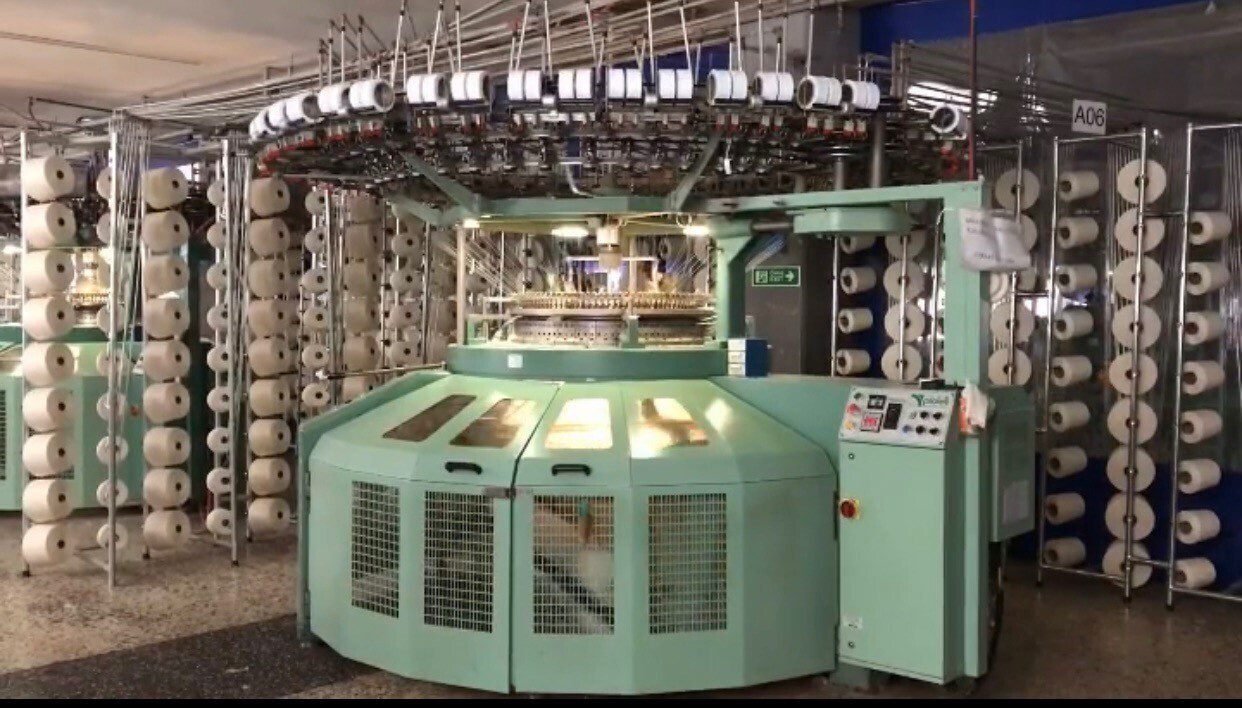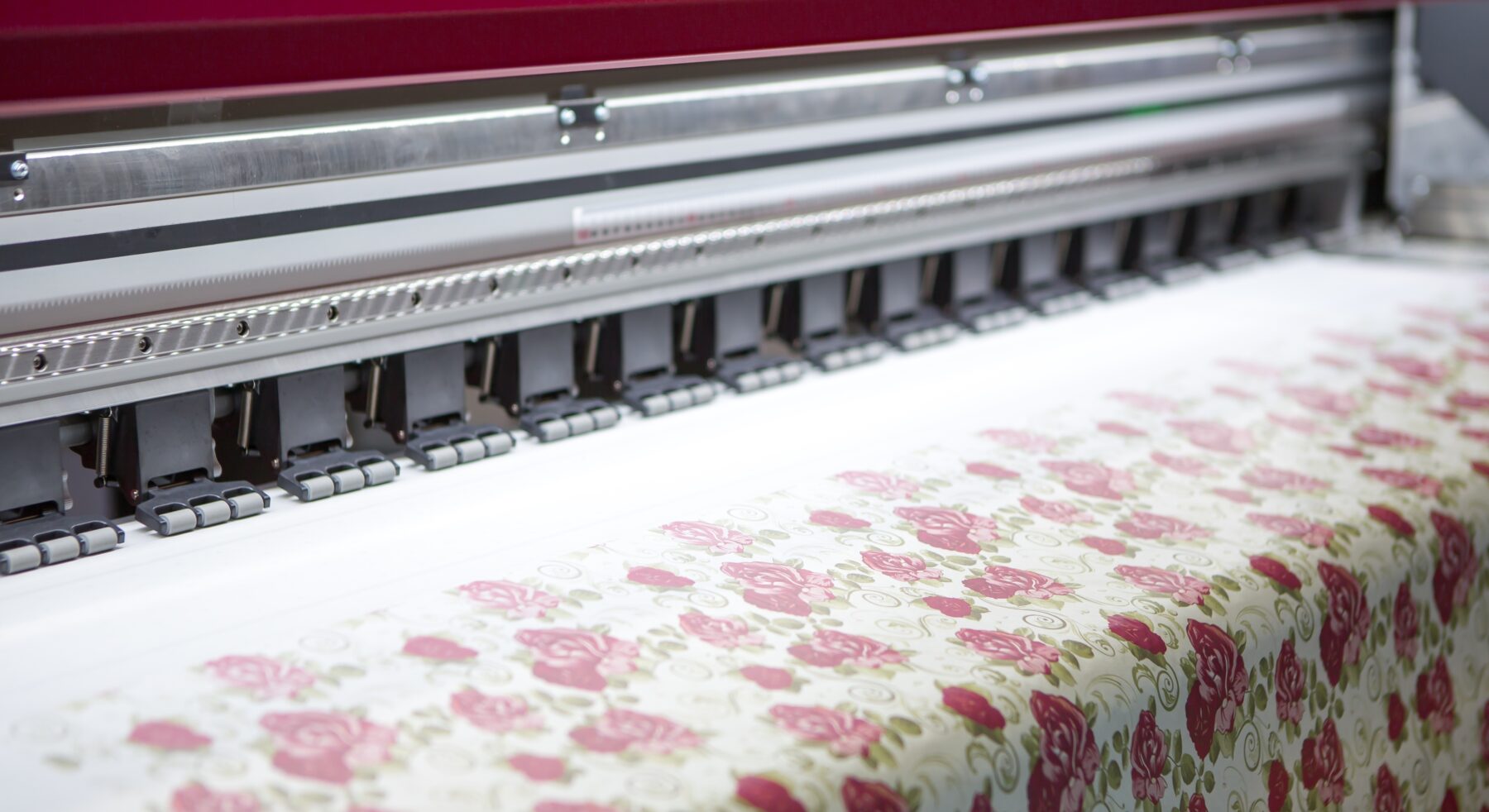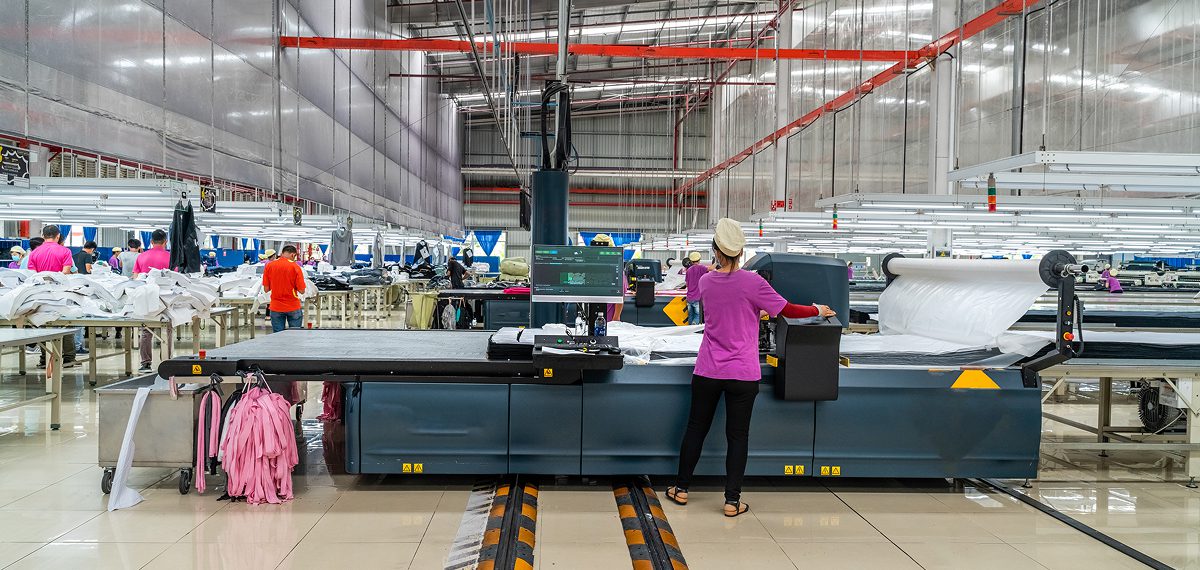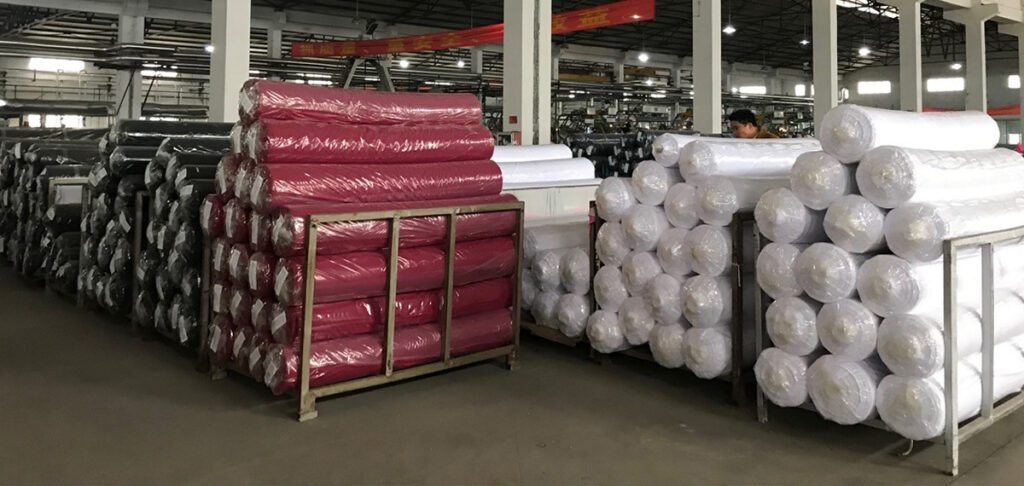
At Pine Crest Fabrics, we’ve recently received a number of questions, such as, “Why can’t we buy U.S.-made stretch performance fabrics?” and “Do you know any U.S. manufacturers of nylon/spandex fabrics?” With ongoing tariff discussions and sourcing challenges, it’s natural to wonder why the fabric behind most modern garments – like yoga pants, swimwear, and performance knits – isn’t made domestically. In this post, we’ll explore the historical context, innovation in fabric development, the economic realities behind domestic production, and why this could not be changed soon.
History of the U.S. Textile Manufacturing
 Spinning cotton yarn in the Great Textile Mills, Lawrence, Mass, 1916, www.loc.gov
Spinning cotton yarn in the Great Textile Mills, Lawrence, Mass, 1916, www.loc.gov
The textile industry flourished in the U.S. from the late 19th century through the mid-20th century, with mills operating across New England and the South. It played a key role in early American industrialization, producing much of the nation’s apparel and fabrics made primarily from natural fibers.
However, starting in the latter half of the 20th century, economic priorities began to shift. As the U.S. moved toward a service-based economy – with growth in technology, finance, healthcare, and education – manufacturing became less central. Globalization, rising domestic labor costs, environmental regulations, and improved production capabilities abroad made moving fabric and garment manufacturing overseas more efficient and cost-effective.
This shift allowed for lower consumer prices, supported economic development in emerging markets, and freed up U.S. resources for innovation-driven industries. While domestic apparel manufacturing was reduced, it was part of the global economy’s natural and strategic evolution.
The Rise of Performance Stretch Fabrics

“Performance” stretch fabrics, typically made from blends like nylon/spandex or polyester/spandex, have revolutionized clothing in the past few decades. Today, stretch fabrics dominate activewear, swimwear, intimates, leggings, loungewear, and everyday basics like T-shirts and socks, thanks to their comfort, fit, moisture-wicking, and quick-dry capabilities. As casual wear and athleisure have taken over closets across the globe, demand for these fabrics has skyrocketed.
By 2010, an estimated 80% of clothing sold in the U.S. contained spandex. That number has only grown with the rise of athleisure and performance-driven fashion.
However, while demand for these fabrics surged in the 1980s–2000s, most U.S. mills had already shifted away from apparel production. The remaining mills focused on industrial and technical textiles, while the infrastructure for making stretch knits was built overseas.
Today, nearly all spandex, nylon, and polyester used in apparel are produced and processed abroad, from fiber production to knitting and finishing; the global supply chain handles everything.
Why These Fabrics Aren’t Made in the USA

The answer lies in timing and specialization. Performance stretch fabrics became popular from the late 1980s through the 2000s – shortly after the U.S. textile industry started offshoring production. When global demand for these innovative knits took off, most American mills closed or shifted focus to industrial, non-apparel textiles.
Meanwhile, Asia – particularly China, Taiwan, South Korea, and Vietnam – invested heavily in the infrastructure to produce synthetic fibers and large-scale high-tech knits. They built supply chains from the ground up, from spandex extrusion to warp and weft knitting and finishing. As a result, today’s performance fabrics are the product of highly specialized, tightly integrated systems – systems the U.S. doesn’t have because the industry had already pivoted elsewhere. In short, the U.S. didn’t stop making performance stretch fabrics – it never started because the demand arrived after domestic apparel fabric manufacturing had moved abroad.
With a strong demand for performance stretch fabrics – and renewed interest in U.S.-made apparel – many people wonder why domestic fabric production isn’t an option. The answer lies in a combination of economic and supply chain realities:
- Labor & Cost: Producing fabric in the U.S. is significantly more expensive. Labor costs alone can make a yard of knit fabric 2–3 times more costly than overseas options — pricing that most brands and consumers won’t absorb.
- Lack of Infrastructure: The U.S. lacks the robust ecosystem needed to support stretch fabric manufacturing at scale. Critical components—such as spandex yarn, advanced knitting machinery, and skilled technicians—are extremely limited and costly. Most state-of-the-art finishing facilities are located overseas.
- No Economies of Scale: Asian mills operate massive, highly efficient facilities. Starting from scratch in the U.S. would mean higher unit costs and smaller capacity, making competing challenging.
- Imported Inputs: While the U.S. hosts a limited number of knitting mills, domestic production of key inputs like spandex and synthetic yarns remains minimal. The LYCRA Company operates the only significant spandex manufacturing facility in the U.S., with the majority of global spandex—approximately 60%—produced in China. Unifi, known for its REPREVE® recycled yarns, is among the few U.S.-based synthetic yarn producers. Due to limited domestic supply and higher production costs, U.S.-made yarns are typically more expensive than imported alternatives.
- Environmental Standards: U.S. mills must meet strict environmental and safety regulations. While important, these increase operational costs compared to factories in countries with looser requirements.
- Industry Focus Elsewhere: The U.S. textile sector today primarily serves industrial, medical, and military markets – not fashion. Most domestic mills are geared toward non-apparel textiles like nonwovens or composites, not stretch knits for activewear.
In short, making stretch fabric in the U.S. today is not only expensive – it’s also logistically difficult and economically impractical.
Could Production Return to the U.S.?

Realistically, it’s unlikely that the U.S. will produce nylon/spandex or polyester/spandex fabrics at scale anytime soon. Rebuilding this capacity would require a massive, multi-year commitment and fundamental changes across several areas:
- Capital Investment: Setting up even one performance fabric mill would require tens or hundreds of millions of dollars in new infrastructure — fiber processing, knitting machines, dye houses, and finishing lines.
- Technology & Automation: Domestic mills need cutting-edge automation and smart manufacturing systems to offset labor costs. While the technology exists, few U.S. companies have invested in it due to the long return on investment.
- Skilled Labor: Much of the textile-specific expertise has retired or moved offshore. Rebuilding a workforce would require deep training, education, and time investment.
- Raw Materials: There are very few options for spandex and synthetic yarns produced in the U.S. The vast majority—over 90% of global spandex fiber—is manufactured in Asia, primarily in China, Vietnam, and India. Expanding domestic capacity would require significant investment, as major fiber producers would need to build new facilities and rebuild a long-dismantled supply chain.
- Environmental Standards: U.S. mills must follow strict regulations for dyeing, finishing, and waste management — essential for health and sustainability but costlier than practices in many overseas facilities. While this reflects responsible manufacturing, it creates a financial disadvantage.
- Policy Support: While government subsidies or tariffs could help, past efforts to revive apparel manufacturing have had a limited impact without a broader national strategy. Policy alone won’t overcome cost or scale barriers.
Even if one or two mills launched today, they would only serve niche markets. To meet even a fraction of U.S. demand – currently 98% fulfilled by imports – would require building multiple large-scale mills from scratch.
Additionally, even if domestic production started, the cost of U.S.-made fabrics would significantly exceed current import prices – far more than any tariff increases. That added cost would be passed to consumers, making everyday garments like leggings or swimwear much more expensive.
What is the best way to source stretch fabrics nowadays?
For now, the global supply chain remains the most efficient and cost-effective way to meet the U.S. market’s stretch fabric needs.
With smart sourcing strategies, strong mill partnerships, and reliable domestic inventory, brands can still meet demand without delay.
At Pine Crest Fabrics, we are well-positioned with trusted international mill partners. Our long-standing relationships allow us to adapt quickly and work closely with suppliers to minimize tariff impacts. We maintain stocked inventory in Portland, giving customers access to in-demand performance fabrics with shorter lead times and potentially reduced tariff exposure.
Sources: The New York Times, Reuters, KQED, McKinsey & Co., NCTO






